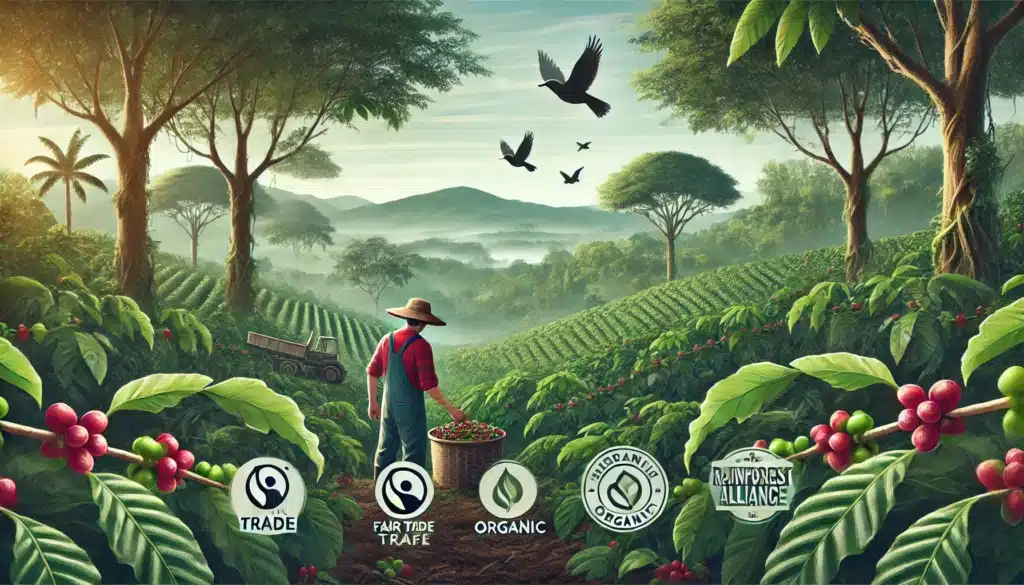Coffee is one of the most widely consumed beverages in the world, but its production comes with a significant environmental footprint. From water use to deforestation, coffee farming can have a large impact on ecosystems.
In this article, we’ll explore the environmental effects of coffee production, highlight the challenges, and suggest ways for consumers to make more sustainable choices.
1. Coffee’s Water Footprint
Coffee farming requires substantial amounts of water, both for irrigation and processing. On average:
- It takes around 140 liters of water to produce one cup of coffee
- Wet-processing methods use even more water, contributing to local water scarcity issues in some coffee-growing regions
To make a positive impact, look for coffee brands that prioritize water conservation and recycling during processing.
2. Deforestation and Habitat Loss
Coffee farming, especially sun-grown coffee, often leads to deforestation and the destruction of natural habitats.
- Shade-grown coffee is a more sustainable option, as it preserves forest ecosystems and supports biodiversity
- By switching to shade-grown, consumers can help mitigate deforestation and reduce carbon emissions associated with land clearing
Choosing certified shade-grown coffee supports more sustainable farming practices.
3. The Role of Pesticides and Fertilizers
Many coffee farms use synthetic pesticides and fertilizers to increase yields. However, these chemicals can:
- Pollute soil and waterways
- Harm local wildlife
- Contribute to environmental degradation
Organic farming methods, which avoid these chemicals, are a more sustainable choice. Look for coffee that is USDA Organic or similarly certified.
4. The Carbon Footprint of Coffee
Coffee’s carbon footprint is influenced by:
- Farming methods (e.g., sun vs. shade-grown)
- Transportation (shipping coffee beans globally)
- Roasting (which releases CO2)
To reduce your carbon footprint, consider buying locally roasted coffee, supporting brands that offset their emissions, or looking for carbon-neutral certifications.
5. Sustainable Farming Certifications
Several certifications help consumers identify coffee that has been produced with sustainability in mind:
- Fair Trade: Ensures fair wages and safe working conditions for farmers while promoting environmentally sustainable practices
- Rainforest Alliance: Focuses on environmental conservation and biodiversity protection
- USDA Organic: Guarantees that no synthetic chemicals or fertilizers were used
- Bird Friendly®: Encourages shade-grown coffee with high biodiversity
Choosing certified sustainable coffees helps drive demand for eco-friendly production methods.
6. The Impact of Coffee Processing
The processing of coffee beans, whether through wet or dry methods, uses considerable amounts of water, energy, and labor. The process also generates waste that can pollute local ecosystems.
Sustainable practices include:
- Water-efficient processing techniques
- Composting coffee pulp and other waste
- Solar-powered drying for beans
Look for brands that prioritize eco-friendly processing methods.
7. The Future of Sustainable Coffee
Sustainability in coffee is evolving. Some innovations include:
- Regenerative farming, which focuses on restoring ecosystems
- The use of alternative packaging (e.g., compostable bags) to reduce waste
- Direct trade partnerships that promote long-term sustainability in both environmental and social aspects
Consumers have the power to push for these changes by choosing brands that prioritize sustainability.
8. How Climate Change Affects Coffee Production
Coffee farming is highly sensitive to climate change, with temperature shifts affecting growing regions, crop yields, and the quality of beans.
As the climate warms:
- Coffee production may shift to higher altitudes or new regions
- Pests and diseases, such as the coffee borer beetle, may become more prevalent
Supporting climate-resilient coffee farms and sustainable practices helps mitigate these effects.
9. Choosing More Sustainable Coffee
Here are some ways to make more sustainable coffee choices:
- Buy certified organic and shade-grown coffee
- Choose brands with transparent sourcing practices
- Support direct trade roasters who pay fair prices and invest in sustainable practices
Every small change you make as a consumer can have a lasting impact on the industry.
10. The Importance of Consumer Awareness
As coffee drinkers, we play a pivotal role in shaping the future of the coffee industry. By being aware of the environmental impact of coffee production and choosing sustainable options, we can:
- Support farmers who prioritize eco-friendly practices
- Push for a more sustainable supply chain
- Help preserve coffee for future generations
Every cup of coffee we drink can either support or harm the planet — make it count.
Final Thoughts: A Conscious Brew for a Sustainable Future
The environmental impact of coffee production is complex, but with informed choices, we can make a positive difference. By supporting sustainable, ethical practices, we help ensure that coffee continues to be enjoyed — for both its flavor and its place in a healthy planet.







